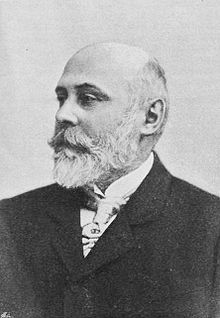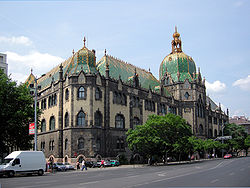- Ödön Lechner
-
Ödön Lechner (Pest, August 27, 1845 – Budapest, June 10, 1914) was a Hungarian architect, nicknamed the "Hungarian Gaudí".
Lechner was one of the early representatives of the Hungarian Secession movement, called szecesszió in Hungarian, which was related to Art Nouveau and Jugendstil in the rest of Europe. He decorated his buildings with Zsolnay tile patterns inspired by old Magyar and Turkic folk art. The Magyar were a people that came from the east, which explains the eastern-like appearance of Lechner's buildings. He combines this with the use of materials modern for his time, such as iron.
His work was submitted in 2008 for inclusion on the World Heritage List.[1]
Contents
Early career
Lechner studied architecture in Budapest and later Berlin at the Schinkel academy. After finishing his studies in Berlin, Lechner departed on a one year tour and study in Italy. In 1869 he went into a partnership with Gyula Partos and the architecture firm received a steady flow of commissions during the boom years of the 1870s, when the construction of buildings lining the ring roads on the Pest side of the Danube occurred. The commissions the partners received were primarily apartment houses in which Lechner worked in the prevailing historicist style, drawing on neo-classical influences from Berlin and the Italian renaissance.
Travel
In 1875 Lechner's wife died, not long after their marriage. He ceased his activities with the partnership and went to Paris, where between 1875 and 1878 he worked under Clement Parent. At this time he was able to familiarise himself with the emerging art nouveau style. He took part in the design and renewal of seven castles. From 1879 he returned to work as before in Hungary and after a trip to London between 1889 and 1890 his style moved away from historicism to embracing the more modern trends of the day. Lechner ended the partnership in 1896 and received less commissions as an independent architect. In 1906 he published a summary of his views in the journal Muveszet. Lechner's final commission was for the Gyula Vermes house in the fifth district of Budapest in 1910-11.
Hungarian secessionist style
Lechner aimed to form a national style, using motifs from Hungarian folk art in the decoration of his buildings as well as incorporating architectural elements from eastern cultures like Persia. Changing directions and curved shapes also distinguish this from the Vienna Secession style. A significant turning point in his career came with a connection to the Vilmos Zsolnay company, and Lechner began to use terracotta tiling in his designs. This new use of modern materials is exemplified in the Thonet business house in Budapest, Váci utca (1889) with its steel structure and the facade covered with Zsolnai terracotta. The pinnacle of Lechner's work is represented in the Postal Savings Bank (the headquarters of the National Bank of Hungary at present) which was completed in 1901. The building's orgy of colours and forms build off art nouveau influences and the emerging European style at the turn of the century, marrying these ideas with Hungarian motifs and eastern forms to create a unique style. The style had many adherents as well as critics. It was to be seen by later generations of architects as a touchstone.
Works
- 1882 Szeged City Hall, together with Gyula Pártos
- 1882 - 1884 Hungarian Railway Pensioners Building (MÁV Nyugdíjintézet bérháza), Budapest, together with Gyula Pártos
- 1885-86 Nagybecskerek City Hall, Kingdom of Hungary (today's Serbia), together with Gyula Pártos.
- 1891 -97 Saint Ladislaus Church (Szent László-plébániatemplom), Kőbánya, Budapest
- 1893 Kecskemét City Hall, together with Gyula Pártos.
- 1896 Budapest Museum of Applied Arts
- 1896 -99 Geological Institute, Budapest
- 1899 -02 The Postal Savings Bank building (Postatakarékpénztár), Budapest
- 1903 Tomb of Schmidl family, Kozma Street Cemetery, Budapest, together with Béla Lajta
- 1906 -08 Royal Catholic Gymnasium in Pressburg, Kingdom of Hungary (today's Slovakia)
- 1907- 08 The Blue Church of Pressburg
- 1909 -12 Saint Ladislaus Church in South Norwalk, Connecticut, USA
- 1907 -13 Saint Elisabeth Church (the Blue Church) in Pressburg
-
Zrenjanin City Hall, today's Serbia (1885-86)
-
The Blue Church of Pressburg (today's Bratislava, Slovakia)
Sources
External links
 Media related to Ödön Lechner at Wikimedia CommonsCategories:
Media related to Ödön Lechner at Wikimedia CommonsCategories:- 19th-century Hungarian people
- Hungarian architects
- Hungarian-German people
- People from Pest
- 1845 births
- 1914 deaths
Wikimedia Foundation. 2010.









